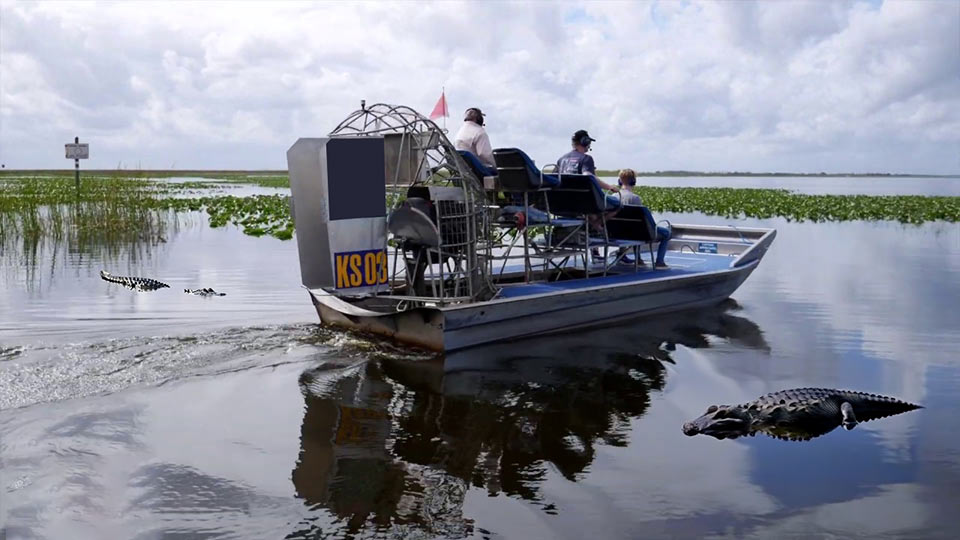The use of AI is slowly growing in all sectors of society and travel & tourism is no different. While the use of photoshopped photos has already existed, we are slowly entering the era of completely made-up photos with AI. We’ll explore the use of AI photos in the travel industry and try and determine who is responsible for informing the traveler they are not real photos.
Let’s create the setup, you plan on taking an everglades air boat ride through the Florida Everglades and as you scroll GetYourGuide, you see amazing photos of this tour. The photos are spectacular, the alligators are relatively close to the boat, and by these amazing photos you book the air boat ride immediately. However, the photos on the listing were all AI generated and when you get to the Everglades facility, you see none of the air boats look recognizable, the alligators are nowhere to be found and the facility looks a little run down. At this moment, you conclude the photos were all completely AI generated and duped you into purchasing this tour over others.
I expect this scenario will happen more and more, as more tourism companies become familiar with AI and discover how they can make very enticing photos that help get more bookings. This is especially true for travel packages that include flights and accommodations. Additionally, luxury travel experiences, such as high-end beachfront resorts with multiple pools and Arabian Gulf views, could also be misrepresented through AI-generated images. But whose responsibility is it to protect the travelers from getting deceived in booking tours based on amazing AI photos?
3rd Party Resellers Should Lead the Way in the World
As 3rd party reseller sites like GetYourGuide and Viator dominate the market, they should lead the way in offering deals and discounts. Why? Well, for starters they either raised millions of dollars or they are publicly trade on the stock exchange, and for these reasons they should help their consumers in pointing out AI generated photos. In fact, as they both have 1000s of tours listed on their sites, I truly believe they should be held accountable for this now.
The first layer in protecting tourists in being deceived comes as the tour company is onboarding the tour to 3rd Party Reseller Sites. GetYourGuide and Viator could ask the company while adding the tour to their sites whether the photos are real or AI generated. Just as the companies ask whether the uploader owns copyrights to the photos they should now flag each photo if they were AI generated. This flag could be visible on their sites as a consumer scrolls the galleries.
By flagging AI-generated photos, consumers can save money by making informed decisions and taking advantage of promotions and discounts.
I feel this responsibility by large travel companies should be happening now. This flagging and tagging of uploaded photos can give the consumer a heads up in deciding to choose this company or go with a different company based upon AI generated photos.
Google is also Responsible to tagging AI photos
Just as we ask 3rd party resellers sites to flag AI generated photos by the tour companies, we should ask Google to flag AI generated photos too. As they too play an important role in providing information that goes into the decision making by a traveler on the internet.
We know, it’s going to be challenging to determine whether every tour company photo published is real or AI generated on Google. We know 3rd party resellers listed tours are uploaded by a person whereas Google is scrapping the website and indexing the results. So they have a differently approach to content but their responsibility is the same. Inform the visitor which photos are AI generated or not. Google’s owned Youtube asks the uploader to choose whether the video is AI generated or not so we know they’re familiar with the ask.
Writing and producing content for the internet involves ensuring the accuracy and authenticity of the information provided, including images.
Plain and simple, Google also has a responsibility in tagging and flagging photos by travel companies and need to help inform visitor if the photos found on the websites are AI generated.
It’s easily conceivable to think, Google scrolls a travel website, indexes the site, indexes the AI images, and displays them in the search results. Google should be held responsible for the images they index and determine whether those images are AI generated as they display them in the results. Since consumers are using Google’s results to visit sites and make bookings.
Is tagging AI photos Good Enough example?
In asking GetYourGuide, Viator and Google to tag AI generated photos to help consumers make better decisions, it’s not enough to ensure they are satisfied with their choices. We will need to teach and inform marketing professionals to have a code of ethics when creating and using AI generated photos. They will need to be educated and encouraged to keep the photos real.
The last thing a travel company would want is for the reviews to state all the photos on the listing were fake.
The impact of AI-generated photos on consumers’ travel experiences can significantly affect their perception of the trip, influencing their overall satisfaction with the service.
Finally, as more and more AI generated photos influence travelers’ decisions, these large companies will need to add a rating system for photos separately. The ranking/rating system will need to ask the consumer if the photos listed represented the tour company honestly. If not, then a lower rating may be selected and displayed.
(For those who read the complete blog post, the alligators in the photo were AI generated.)
